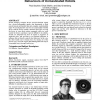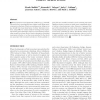259 search results - page 26 / 52 » Personalizing CS1 with robots |
HRI
2009
ACM
14 years 4 months ago
2009
ACM
Several emerging computer devices read bio-electrical signals (e.g., electro-corticographic signals, skin biopotential or facial muscle tension) and translate them into computer- ...
IROS
2008
IEEE
14 years 4 months ago
2008
IEEE
— To achieve accurate and efficient interaction with humans, robot training is indispensable to make robot cooperate with different host. We are focusing on development of a huma...
AI
2004
Springer
13 years 9 months ago
2004
Springer
Over the last years evidence has accumulated that shows the possibility to analyze human brain activity on-line and translate brain states into actions such as selecting a letter ...
HCI
2009
13 years 7 months ago
2009
Abstract. The purpose of this research is to emphasize on the concept of integrating computer and interactive technologies to the rehabilitation robotic with biofeedback. First, th...
JOCN
2010
13 years 4 months ago
2010
When exposed to novel dynamical conditions (e.g., externally imposed forces), neurologically intact subjects easily adjust motor commands on the basis of their own reaching errors...



